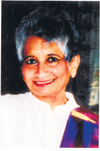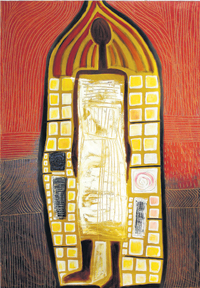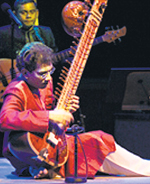|
|
|||||||||||||
|
Chickeras take centre stage
There is always something to be said for keeping it in the family; this family being a case in point. To say that Ruwanthie, Gihan and Amal de Chickera have in recent years made an impression on the local drama scene would (as you probably know) be something of an understatement. The truth is that they have done a good deal of stretching, flexing and general pushing and pulling, as a result of which Sri Lankan theatre will, quite literally, never be the same again.
“We don’t step on each other’s toes,” says Ruwanthie seriously, explaining that each of them have their own areas of expertise - Ruwanthie as a writer/director, Gihan with music, choreography and acting and Amal as a producer. “I started writing plays when I was 16,” she says, adding that it was not long before they realized that Gihan was a fabulous actor. Amal, the youngest of the three, stepped quite naturally into the only space left – that of chief organizer. More recently, Shakthi, Ruwanthie’s husband is also becoming more involved. Together they set up the Stages Theatre Group in 2001. Since then the group has been responsible for expanding Sri Lankan theatre through a number of original plays, translations, bilingual plays, devised plays, tours and workshops. Stages has also successfully produced six critically acclaimed dramas to sell-out audiences in Sri Lanka. With their latest production, “CHECKPOINT – three strangely normal plays”, the trio are back in the limelight. Though you may have caught the performance in 2001 at the British Council, theatre lovers would be well advised not to miss this one, not only because it once again sports a widely talented and expanded cast, but also because as a director, Ruwanthie herself will never be content to merely redo a piece. Not a re-enactment goes by when she does not slip in some new twist or variation. However, those who love the familiar will be glad to know that the performance of ‘Last Bus Eke Kathawa,’ will be more or less the same. Gihan, who is probably best known for his role as Amarawansa is also returning to the stage. “Gihan has grown with the part,” says Ruwanthie, adding that he’s had plenty of time to do that – it’s been nearly six years since he first took on the role of a labourer caught in the middle of the 1989 JVP insurrection. The same applies to the others; “it’s almost as if our whole team is somehow more mature,” says Amal. This time around, the cast list itself is longer and the forum theatre pieces in particular are also entirely new. For Ruwanthie herself, a lot has changed. “I’ve become a lot more demanding of my actors,” she says, adding that she has come to expect a great deal of professionalism and commitment from those she works with. This is particularly true of forum theatre which is challenging in comparison to the straightforward performance required in most plays. After all, there’s no knowing what suggestions the audience might offer, and no script to fall back on. “It demands real identification with the character,” says Ruwanthie. In other aspects too, changes have snuck in. “I’ve always had a real fascination for language,” Ruwanthie explains. Ruefully, she admits that her love affair with words has in the past led her to neglect the other aspects of drama such as visuals, technology or sets; a state of affairs that has already begun to change. Beginning with the collaborative play ‘Babur – Memoirs of a Legend’ (2004), Ruwanthie was determined not to focus on words; instead she wanted to use movement to communicate as opposed to language. Since then, there’s been no looking back. So much so, that one of Stages upcoming productions will be entirely based on visuals, with not a word to be heard, while another promises to be technology heavy. CHECKPOINT – Three Strangely Normal Plays will be performed by the Stages Theatre Group in the new state-of-the-art British School Auditorium, from September 1st to the 5th. Tickets are available at Cargills Food City outlets at Staples Street, Kollupitiya, Nawala and Thimbirigasyaya and the KPMG office in Colombo and at the gate on performance days. The cast includes some of the best known names in English Theatre, such as Mohamed Adamaly, Tracy Holsinger, Nimmi Harasgama, Piyumi Samaraweera, Ryan Holsinger, Ruhanie Perera, Shanaka Amarasinghe, Gihan de Chickera and Dylan Perera. The production serves as a fundraiser for a tsunami housing scheme funded by the KPMG Foundation and is sponsored by Mobitel.
Something to admire, something to think about... Images … Images, sometimes they move so fast These lines are for Daisy Campbell our friend who
shared with us her 'Images'.
' Images ' is undoubtedly a treasure since it carries one through countries, through nature, over the deep sea and sometimes into the depths of it. The collection includes people and places, collages and semi-abstracts and then eighteen of Daisy's paintings where the medium is pencil on paper. "This book covers much of the work in Daisy's possession at the time of printing, plus a few from nearby collectors," says Bill in the Editor's note. "The layout gives each piece space for examination and contemplation on its own." I believe that those of us who were privileged to get a copy of 'Images' did just that… contemplate and admire. That is what I did and what I still do. I turn the pages of this masterpiece and fall on the Keena trees of Horton Plains and the Redwoods of California, I find myself on that Indonesian sloop far out at sea, or watch the blooming of the yellow water lily. The savage sea painted by Daisy brings out the blacks and the dark blues and then, as if to calm the mind, the ballet dancers. The music and the movements … Daisy says of her work, "My styles vary, depending on the subject. The medium I use also depends on the subject but I like to see a balance in whatever I paint." I believe it is this balance that makes Daisy's paintings come out as totally coherent and 'stable'. They have a completeness about them that is unique. I see 'Images' as a beautiful and professionally crafted work of art - a work of art at its extreme best. Thank you Daisy and Bill for sharing these unforgettable 'Images' with us.
Less colours but same depth
"We live a surface life. The current fashion is to become rich and famous as fast as possible, and by trying to do this many people miss out on the simple beautiful ways of living a full life," Preethi Hapuwatte says explaining her latest work. For her, art is not merely an expression of feeling, but something more. She wishes to propagate the message that it is one of the simple ways by which one may attain fulfilment and joy.
Her new exhibition titled 'Life on Earth' records some of her experiences up to this point of time in her life - both good and bad. Her travels through Sri Lanka and abroad find expression in her paintings. One notices how simple things have had a great impact on her. Her new paintings draw from primitive art forms and her intricate painting technique brings to mind the painting style of Australian aboriginal artists. Swiss artist Paul Klee has always been an inspiration for Preethi. But the overall composition is totally hers. Having held exhibitions annually from 1994, this being her ninth solo exhibition at the Barefoot Gallery, anyone who has been following her work will have noticed a change in colours.
Previously, her work has displayed a varied and vibrant palette. However, this time she has restricted herself to earth tones of mainly white, ochre, red earth and black. "I took it up as a challenge to restrict my palette as a part of a disciplining experience for myself to prove how much can be done with so little." However the depth and quality of her paintings are not compromised by this change. Hailing from a background of artistic talent, Preethi speaks of her early steps in art. "Both my parents, the Ratnavibhushanas, have aesthetic and artistic inclinations. My father was an electrical engineer by profession but a photographer and painter as well. My mother was a housewife and painter." The talent has passed down to the next generation as well. Preethi's daughter is a talented painter. Joining Barefoot at the age of 16 years and working
with them since has taken her a long way, she says. She currently
designs the toys and bags at Barefoot.
It was not so much the melody but the mood, not the experience but the effect Pradeepanjalee takes Los Angeles by storm It would hardly be an exaggeration to qualify the recent musical concert performed by an ensemble of talented and famed Sri Lankan and American artists as one of the most unique and gratifying events in the Sri Lankan community in Los Angeles. Pradeep Ratnayake and his troupe presented an amalgam of Indian classical music with Sri Lankan folk tunes fused with Jazz music with artists Eric Marienthal on sax, Freddie Ravel on piano and Hussain Jiffry on bass.
Nothing like a musical evening to purge away the hours of fatigue and monotonous routine of the week I thought, as I made my way through the awe inspiring architectural structures of the Disney Concert Hall. What awaited the audience that evening was more than just music. It was an experience of what music could become in the hands of the artist with exquisite talent, indefinable creativity and spontaneity. It was an experiment of music beyond culture and barriers, a place in time where East meets West. Today of all times, the Sri Lankan cultural sphere in Los Angeles seems to be one of the most active ever, displaying an array of entertainment to suit each others’ tastes. As a matter of fact, one barely has a chance to get over last week’s play before setting off in a hurry to catch the next Baila musical concert. The majority of the musical events I have had the pleasure of assisting so far seemed solely destined to satisfy an audience seeking an evening of entertainment based on amplified sounds, monotonously uncomplicated rhythm, with a preference for accelerated and dance appropriate beats. Thus, “Pradeepanjalee” was to me a long awaited breath of fresh air bringing droplets of novelty to the arid musical taste of our Sri Lankan community. The most striking feature of this evening’s concert was beyond doubt the ingenious performance of Sitarist Pradeep Ratnayake. A magical combinations of sounds seemed to emanate from the instrument as the artist’s fingers slid to and fro along the strings. The strokes were bold and passionate yet soft and romantic, in tune to the mood of the Raga he chose to demonstrate. The accompanying Tabla and from time to time, a touch of the ethnic Sri Lankan percussions, added a curiously new dimension to his music. Some of Pradeep’s compositions performed this evening were a tribute to the simple and un-spoilt beauty of Sri Lankan folk music, elements of which were subtly woven through the sophisticated musical patterns of Indian Classical Music. It is unusual and novel to hear the fusion of the Sinhala Vannam played on a sitar with such eloquence to the rhythm of the customary “Geta Bera”. Fusion of music occurred on various levels and at different times throughout this concert. When Indian music met with Jazz music, the outcome could not have been more explosively harmonious. The audience swung to and fro in their seats keeping beat to the invigorating and enticing tunes of the Saxophone, Piano and Violin. They applauded as the Sitar made its way into this land of music yet unaccustomed to it, improvising through new notes and resonance. What will remain with me from this evening is not so much a melody as the mood it created, not so much the experience as the purifying and wholesome effect it had on me. Thus, my heartfelt gratitude to the Sri Lanka Foundation for its effort in bringing music to the lives of the many Sri Lankans in California and providing a creative backdrop for promising Sri Lankan artists. |
|||||||||||||
Copyright © 2006 Wijeya Newspapers
Ltd. All rights reserved. |




